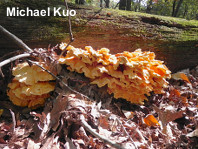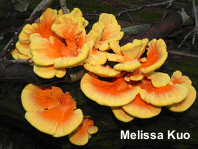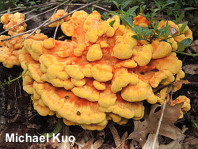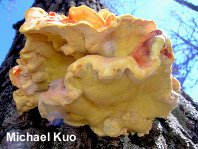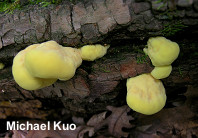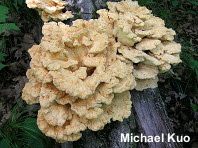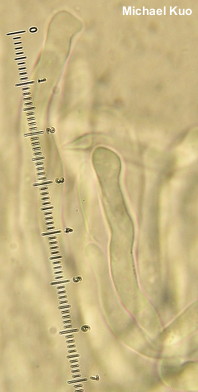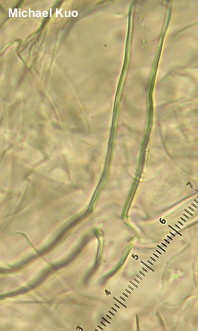| Major Groups > Polypores > Laetiporus > Laetiporus sulphureus |

|
Laetiporus sulphureus [ Basidiomycota > Polyporales > Laetiporaceae > Laetiporus . . . ] by Michael Kuo Laetiporus sulphureus, often called the "chicken of the woods," appears in eastern North America's hardwood forests, where it causes a brown heart rot in the wood of standing and fallen oaks and other hardwoods. Since it is a heart rot fungus, the mushrooms appear above ground (often high on the tree)—or in a position that would have been above ground before the trunk fell. Distinctive physical features for Laetiporus sulphureus include its yellow-orange colors and the fact that it usually grows in overlapping, shelving clusters. Its flesh is soft (for a polypore), and its pore surface is yellow—although a white-pored version also exists (see below). In western North America there are several similar species (see the key to Laetiporus) and, in eastern North America the similar Laetiporus huroniensis appears on conifer wood. Laetiporus cincinnatus also appears in eastern hardwood forests, but is a root and butt rot fungus and therefore usually appears at the butt of the tree or on the ground near its base; additionally, Laetiporus cincinnatus grows in rosettes and has pinkish orange colors, a whitish pore surface, and smaller spores. A white-pored Laetiporus sulphureus, distinct from Laetiporus cincinnatus, is sometimes reported; Linder and Banik (2008) found some DNA support for the separation of a white-pored species or variety, but cautioned that further research is needed. Since the chicken of the woods is often a parasite, there is a good chance that it has killed its host tree. However, the mushrooms do not appear until well after the fungus—in the form of mushroom-less mycelium—has attacked the tree. By the time the chickens appear, they are definitely coming home to roost, as far as the tree's health is concerned, and the fungus cannot be "removed" by removing the mushrooms. According to mating and DNA studies (Banik et al 2010, Song & Cui 2017) there are actually at least two candidates for the true Laetiporus sulphureus: one is limited to Europe and appears on the wood of hardwoods or conifers, while the other is distributed in Europe, North America, and South America and is limited to hardwoods. The two species, though well defined, are apparently morphologically inseparable, at least on current data. Since Laetiporus sulphureus was originally named from France (by Bulliard, who called it "the sulphur bolete," in 1780) the species will have to be redefined in a contemporary sense on the basis of French collections and, if the Europe-only species is selected, our North American species will need a name. Description: Ecology: Parasitic and saprobic on living and dead oaks (also sometimes on the wood of other hardwoods); causing a reddish brown cubical heart rot, with thin areas of white mycelium visible in the cracks of the wood; annual; growing alone or, more typically, in shelving clusters above the ground; summer and fall, rarely in winter and spring; widely distributed east of the Rocky Mountains. The illustrated and described collections are from Illinois, Kentucky, and Ohio. Fruiting Body: Up to 90 cm across; usually consisting of several to many individual caps arranged in a lateral shelving formation, but sometimes forming rosettes when growing on top of a fallen log. Caps: 5–25 cm across and up to 20 cm deep; up to 3 cm thick; fan-shaped to semicircular or irregular; more or less planoconvex; smooth or finely wrinkled; suedelike; bright yellow to bright orange when fresh—often yellow-orange overall, with a bright to dull yellow margin; fading to dull yellowish and, eventually, nearly white when long past maturity. Pore Surface: Bright to dull yellow (or rarely white; see discussion above); not bruising; with 2–4 circular to angular pores per mm; tubes to 5 mm deep; fading to dull yellowish. Stem: Absent. Flesh: Thick; soft and watery when young, becoming tougher and eventually becoming chalky and crumbling away; white to pale yellow; not changing when sliced. Dried Specimens: Cap surface and pore surface retain yellow hues for at least 8 years in the herbarium, and can be distinguished from herbarium specimens of Laetiporus cincinnatus, which lack yellow hues. Odor and Taste: Not distinctive. Chemical Reactions: KOH negative on flesh and cap surface. Spore Print: White. Microscopic Features: Spores 5.5–7 x 3.5–5 µm; ellipsoid; smooth; hyaline in KOH; inamyloid. Hymenial cystidia not found. Contextual hyphal system dimitic. Contextual binding hyphae 4–14 µm wide; often branching; aseptate; smooth; walls 1–2 µm thick; hyaline in KOH. Hymenial trama generative hyphae 4–7 µm wide; tubular and unbranched; usually parallel; septate; smooth; thin-walled; hyaline in KOH. Clamp connections not found. REFERENCES: (Bulliard, 1780) Murrill, 1920. (Fries, 1821; Saccardo, 1888; Smith, 1949; Overholtz, 1953; Smith, Smith & Weber, 1981; Weber & Smith, 1985; Arora, 1986; Breitenbach & Kränzlin, 1986; Gilbertson & Ryvarden, 1986; Phillips, 1991/2005; Lincoff, 1992; Metzler & Metzler, 1992; Horn, Kay & Abel, 1993; Barron, 1999; Banik & Burdsall, 2000; Burdsall & Banik, 2001; Roody, 2003; McNeil, 2006; Miller & Miller, 2006; Kuo, 2007; Binion et al., 2008; Lindner & Banik, 2008; Banik et al., 2010; Kuo & Methven, 2014; Justo et al, 2017; Song & Cui, 2017.) Herb. Kuo 11010907, 07291203, 05181601. This site contains no information about the edibility or toxicity of mushrooms. |
© MushroomExpert.Com |
|
Cite this page as: Kuo, M. (2017, November). Laetiporus sulphureus. Retrieved from the MushroomExpert.Com Web site: http://www.mushroomexpert.com/laetiporus_sulphureus.html |
